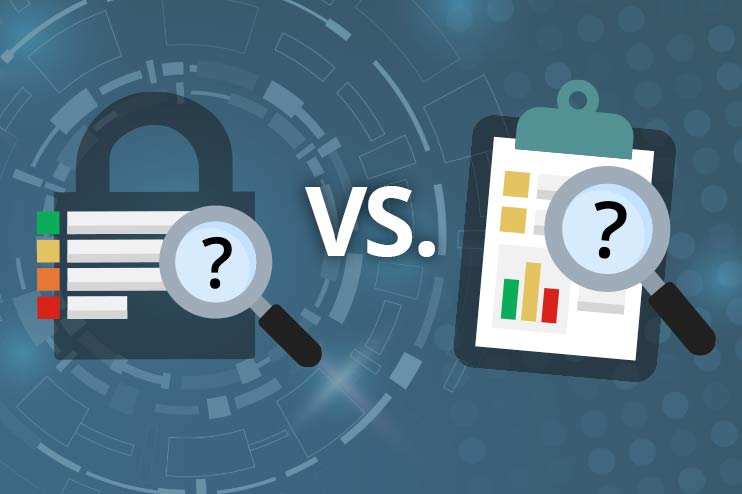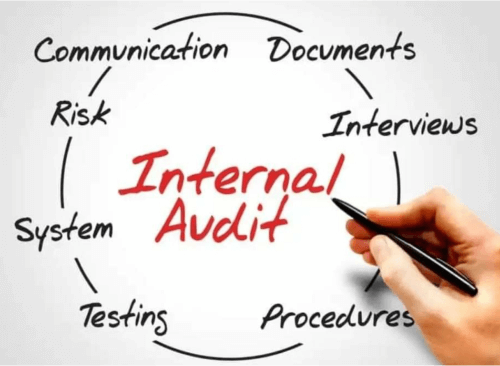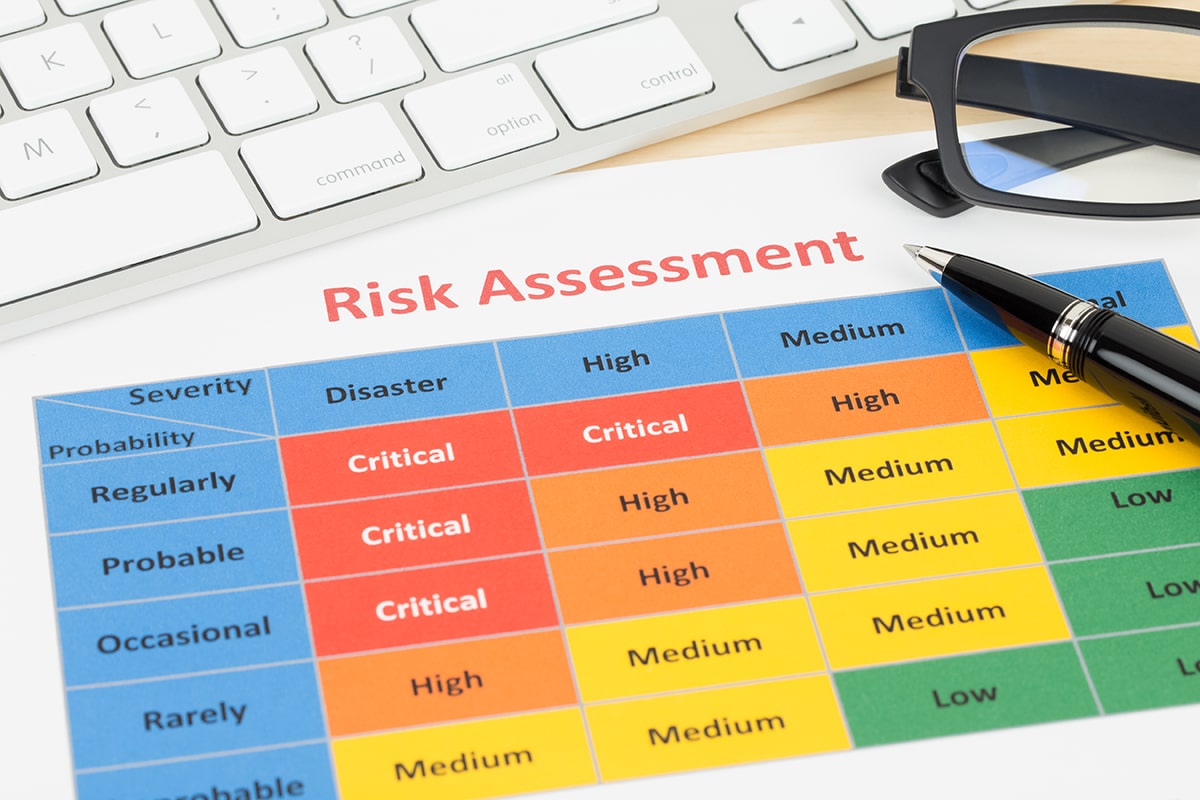
Audit & Analysis
Let our talented team engage with you to
a perform an audit & analysis of core systems of your business
Audit & Analysis
Services
Cybersecurity Audit vs. Cybersecurity Assessment: What's the Difference?

While the two are related, assessments and audits are distinct cybersecurity and compliance evaluation mechanisms.
It’s important for security leaders to understand exactly how the two function in order to drive organizational cyber maturity and meet industry-specific regulatory requirements.
How does a cybersecurity audit differ from a cybersecurity assessment?
A cybersecurity audit is a point-in-time evaluation which verifies that specific security controls are in place. A cybersecurity assessment is a high-level analysis that determines the effectiveness of those cybersecurity controls and rates an organization’s overall cyber maturity. While audits are usually conducted by an independent third-party auditor aligned with a regulatory framework (such as HIPAA), they can also be performed internally in preparation for the latter.


Whether performed internally by a team acting as an independent agency or by an external regulatory agency, audits differ from assessments in that they tally an organization’s controls, policies and procedures against a specific checklist in order to verify compliance. While audits serve an important regulatory purpose, internal audits don’t always tell the whole story when it comes to the effectiveness of an organization’s cybersecurity program.
What can and can’t be learned from internal audits and assessments?
Organizations looking to improve their security posture should be aware of the limitations of internal audits. While running down a checklist of security controls can verify that the specified controls are in place, this action doesn’t guarantee their effectiveness in mitigating cyber risk. For example, confirming the presence of access controls doesn’t mean much if they aren’t properly configured. Audits can also fail to identify potential vulnerabilities beyond the factors that are specified.
Unlike audits, cybersecurity assessments are informed by desired business outcomes such as continuity and resilience. Rather than simply checking the boxes, an effective assessment provides an in-depth look at the effectiveness of a company’s security program. A cyber risk assessment can also help security leaders identify cybersecurity gaps and plan remediation activities.

Why perform cybersecurity assessments?
Performing a comprehensive assessment that covers the full spectrum of cyber risk is essential to gauging an organization’s level of preparedness for security incidents. Important processes such as security event and third-party risk monitoring are beyond the narrow scope of most audits. Performing a high-level analysis of a company’s cybersecurity program also allows business and security leaders to make informed, risk-based decisions in consideration of other important factors such as:– The location of a company’s most valuable assets.
– The data that poses the greatest business risk in the event of a breach.
– Which vendors are business-critical.
– Which vendors handle the most sensitive data (i.e. customer data).
The broad operational perspective gained allows organizations to determine where their systems are most vulnerable, ensuring that cybersecurity spending is proportional to each area of risk. These findings can then be mapped to industry standards and inform security leaders on which areas require further investigation.
Self-assessments help prepare for regulatory audits
As we mentioned above, cybersecurity assessments and audits are two separate but related stages of the cybersecurity evaluation process. An audit provides a compliance snapshot, while an assessment provides a high-level view of cyber maturity. Ideally, an assessment precedes an audit and serves as a preparation tool. In preparation for an internal audit, assessments help the auditing committee identify risk areas that require the most scrutiny, and which security controls are needed that may not be in place.
Companies that conduct internal self-assessments on an ongoing basis are more likely to succeed when faced with external regulatory audits. Organizational security posture can slide between audits, which are point-in-time evaluations that quickly become outdated. Technology solutions like security ratings are a great way to continuously monitor security and compliance posture.
Using Standard Language: Types of Cybersecurity Audits and Assessments
Here is a handy reference of standard cybersecurity assessment and audit terms:
Controls (or Controls Library)
A control is a rule or requirement that is designed to drive a specific objective. A controls library is simply a list of the controls. The business objective, and an established test for the control is often, but not always, included in the library.
Cybersecurity Audit
An audit is typically defined as an evaluation of performance against specifications, standards, controls, or guidelines. This is often a checklist exercise where there is an evaluation against a list of controls called the controls library. The effectiveness, comprehensiveness, and business appropriateness of those controls are not obvious.
Cybersecurity Assessment
Assessments come in many shapes and sizes, and typically deliver a much deeper evaluation of performance against, or adherence to, the controls. Assessments usually include some sort of impact measure or an interpretation of the effectiveness of the area being assessed. Assessments may include some degree of an audit but not always.
Penetration Testing
This is neither an audit or an assessment. It is a situational test that looks at one point in time. It is a trial to the controls, monitoring, processes, and technologies that protect an environment. It provides no measure but an anecdotal data point and a narrative. There is value in this exercise, however it is not a satisfactory replacement for audits or assessments.
Assessment and Audit Types and Purposes
Here are six of the main types of standard assessments or audits:

Cybersecurity Compliance:
Compliance assessments evaluate an environment against a reference model. That reference model could be a governance or regulatory framework, such as PCI, SOX, NIST 800-53 or ISO 27000. Typically, there is a review of the controls for comprehensiveness and effectiveness, followed by an audit against the controls. Lastly, a risk valuation is typically completed. A compliance assessment will show how well a compliance program is performing and make improvement recommendations, as well as show some degree of a risk value.

Cyber Maturity:
A cyber maturity assessment is an evaluation of the level of maturity an organization has with respect to its technology, people, and processes. The measure is made against a reference model, such as the DoD CMMC (Cyber Maturity Model Certification) or the DoE C2M2 (Cyber Capability Maturity Model). Within those standards, there are different standard maturity levels. This type of assessment provides a good picture of where there are maturity gaps or weaknesses in the overall cybersecurity program. It is also a good indicator of where investments should be made at a very high level. Typically, there is less emphasis on risk and more focus on having a comprehensive program.

Current-State Assessment:
A current–state assessment is a group of assessments designed to support the strategic development of the cyber program. The current–state is matched against where the program wants to be or its desired future–state. These assessments focus on capability, technology, maturity, or any other measure that could drive change or improvement.

Risk Assessment:
A risk assessment is a specific type of assessment that identifies, measures, and analyzes risk. The scope could include a regulatory or compliance framework, an application, a business process, a critical investment, or business decision. The likelihood and impact of the risk, as well as mitigation or remediation strategies, is the priority. The deliverables from many of the other assessments and audits discussed here can be used as inputs for the risk assessment. The key business outcome should include a quantifiable measure of business risk.

Threat Assessment:
A threat assessment is a review of the in–scope operating environment, network, application, or process with an intent to measure the significance, likelihood, and mechanisms associated with risks. This assessment is heavy on analysis and is often carried out with a great deal of risk or threat modeling. The business outcome of a threat assessment should be an increased understanding of the most pressing threats to an organization and their level of severity.

Cyber Resiliency:
A cyber resiliency assessment measures an organization’s ability to identify, withstand, or recover from a cyberattack or breach incident. This is a very pragmatic and applied approach that should provide a very accurate view of the organization’s cyber posture.
Each of these evaluations answer different business questions and provide varied informational and business-decision insight. The differences among them can be subtle or pronounced. Understanding what you need and gaining clarity on which questions you need to answer will help ensure that you choose the right assessment to answers those questions.
Our Approach – How Hurd IT’s Risk Matrix process can help

Hurd IT’s Risk Matrix goes beyond the narrow scope of audits by gathering comprehensive risk data across 10 factor groups, including network security, patching cadence, hacker chatter, and IP reputation. Our “Enterprise-view” displays the most critical and common organizational risks, so security teams can drill down and prioritize remediation.
Working together, we establish a Risk Matrix which is unique to your business and addresses potential threats that can impact and cripple your organization. This also provides SLAs internal in your organization to better understand the overall impact beyond “cost/profitability” models and can aid in overall capacity planning for “Smart Growth”.
Engage Hurd IT
Engage with us
to empower your business
Our mission is to operate without limits and offer our clients solutions that mold to their business needs, to offer these services with cloud technology at its forefront and security at it's core.

Some of our strategic partnerships





























